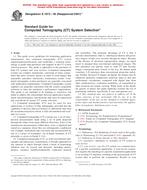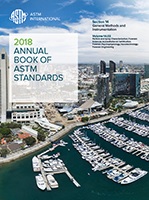Original price was: $58.00.$34.80Current price is: $34.80.
Standard Guide for Computed Tomography (CT) System Selection
standard by ASTM International, 01/01/2001
Description
1.1 This guide covers guidelines for translating application requirements into computed tomography (CT) system requirements/specifications and establishes a common terminology to guide both purchaser and supplier in the CT system selection process. This guide is applicable to the purchaser of both CT systems and scan services. Computed tomography systems are complex instruments, consisting of many components that must correctly interact in order to yield images that repeatedly reproduce satisfactory examination results. Computed tomography system purchasers are generally concerned with application requirements. Computed tomography system suppliers are generally concerned with the system component selection to meet the purchaser’s performance requirements. This guide is not intended to be limiting or restrictive, but rather to address the relationships between application requirements and performance specifications that must be understood and considered for proper CT system selection.
1.2 Computed tomography (CT) may be used for new applications or in place of film radiography, provided that the capability to disclose physical features or indications that form the acceptance/rejection criteria is fully documented and available for review.
1.3 Computed tomography (CT) systems use a set of transmission measurements made along a set of paths projected through the examination object from many different directions. Each of the transmission measurements within these views is digitized and stored in a computer, where they are subsequently conditioned (for example, normalized and corrected) and reconstructed by one of a variety of techniques. An in-depth treatment of CT principles is given in Guide E1441.
1.4 Computed tomography (CT), as with conventional radiography and radioscopic examinations, is broadly applicable to any material or examination object through which a beam of penetrating radiation may be passed and detected, including metals, plastics, ceramics, metallic/nonmetallic composite material and assemblies. The principal advantage of CT is that it provides densitometric (that is, radiological density and geometry) images of thin cross sections through an object. Because of the absence of structural superposition, images are much easier to interpret than conventional radiological images. The new purchaser can quickly learn to read CT data because images correspond more closely to the way the human mind visualizes 3-D structures than conventional projection radiology. Further, because CT images are digital, the images may be enhanced, analyzed, compressed, archived, input as data into performance calculations, compared with digital data from other nondestructive evaluation modalities, or transmitted to other locations for remote viewing. While many of the details are generic in nature, this guide implicitly assumes the use of penetrating radiation, specifically X rays and gamma rays.
1.5 This standard does not purport to address all of the safety concerns, if any, associated with its use. It is the responsibility of the user of this standard to establish appropriate safety and health practices and determine the applicability of regulatory limitations prior to use.
Product Details
- Published:
- 01/01/2001
- Number of Pages:
- 10
- File Size:
- 1 file , 130 KB
- Note:
- This product is unavailable in Russia, Ukraine, Belarus





